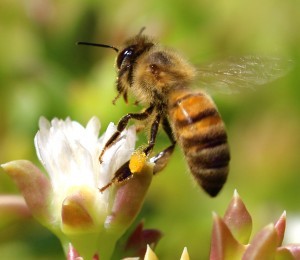10
Aug
Reports of Increasing Honey Bee Colonies Mask Continuing Pollinator Crisis
(Beyond Pesticides, August 10, 2017) New data released by the U.S. Department of Agriculture (USDA) earlier this month, indicating a slight increase in the number of honey bee colonies, is masked by beekeepers’ efforts to split hives in the face of losses. The USDA reports that Colony Collapse Disorder losses (CCD) are down 27% compared to the past year. While  these numbers may seem to be a positive sign after over a decade of consistent pollinator declines, they are more indicative of a beekeeping industry that is using every available tactic possible to stay viable. With the continued use of highly toxic neonicotinoid insecticides in farms, gardens, and public spaces throughout the country, the long-term health honey bees and other pollinators continue to be in jeopardy.
these numbers may seem to be a positive sign after over a decade of consistent pollinator declines, they are more indicative of a beekeeping industry that is using every available tactic possible to stay viable. With the continued use of highly toxic neonicotinoid insecticides in farms, gardens, and public spaces throughout the country, the long-term health honey bees and other pollinators continue to be in jeopardy.
According to USDA’s National Agricultural Statistics Service (NASS), the number of beekeeping operations with five or more colonies reported a total of 2.89 million colonies in April 2017, a 3% increase from April 2016, when numbers stood at 2.80 million. News media such as Bloomberg hailed this report in an article headlined “Bees Are Bouncing Back From Colony Collapse Disorder.” However, a closer look into the numbers and beekeeper accounts reveals what is actually occurring.
A more accurate reference point for the beekeeping industry would be beekeeping numbers reported in January 2017, during winter, which at 2.62 million remained unchanged from January 2016. Overall increases from January to April likely represented beekeepers ‘splitting’ hives, a practice through which beekeepers will create two or more hives from a singular strong hive. Although on paper this is displayed as an increase in hive numbers, in reality these hives are weaker than the colony from which they originated.
Tim May, a beekeeper in Harvard, Illinois and the vice-president of the American Beekeeping Federation based in Atlanta, who was interviewed by Bloomberg, indicates that this is the case. “You create new hives by breaking up your stronger hives, which just makes them weaker,” said Mr. May to Bloomberg. “We check for mites, we keep our bees well-fed, we communicate with farmers so they don’t spray pesticides when our hives are vulnerable. I don’t know what else we can do.”
A separate report from the Bee Informed Partnership published in late May 2017 indicates that colony declines over the past year stood at 33%, which is less than losses of 44% seen in the 2015-2016 loss reports, however far from normal, or economically viable rates. As the USDA NASS report indicates, reports of CCD, the name given to the mysterious disappearance of honey bees from an otherwise healthy looking hive filled with honey and brood, have decreased significantly. While this also appears to be good news, it is understood based upon past Bee Informed Partnership surveys that while CCD reports are down, summer colony losses ascribed to other, understood loss factors are up.
Despite continued attempts by the pesticide industry to spin the crisis by suppressing or denying evidence, scientific reports continue to point to neonicotinoid insecticides as the key factor in pollinator declines. A recent report funded by Bayer and Syngenta, the world’s two leading neonicotinoid manufacturers, actually found significant risks to pollinators, despite attempts by these two companies to influence the published results. It is little wonder why these corporations have needed to change their tune, if only slightly. In the Bloomberg article, when questioned over the impacts of pesticides, Syngenta CEO Erik Frywald had to admit that, “One of the very minor elements there is pesticides.” As one may expect from an industry CEO with vested interest in maintaining marketshare and profit, this is a vast understatement, but nonetheless indicative of a reality that even industry can no longer ignore.
In Europe, applying neonicotinoids to field crops has been banned since 2013, and the European Commission recently proposed expanding the prohibition and making it permanent. EPA data published earlier this year did find risks to pollinators from neonicotinoid insecticides, however the agency, which has long been accused of being captured by industry interests, suggested no substantive changes to their regulation.
While beekeepers and managed honey bee colonies continue to muddle through the ongoing crisis, reports indicate that wild pollinators may be at even greater risk. A review published by the Center for Biological Diversity this year indicates that 1 in 4 native bee species in North America are imperiled and at increasing risk of extinction.
Help stop the damage pesticide makers are causing to wild pollinators and the beekeeping industry by getting involved. Find the tools you need to advocate for pollinators in your community, state, and to the EPA through Beyond Pesticides’ Bee Protective webpage.
All unattributed positions and opinions in this piece are those of Beyond Pesticides.










